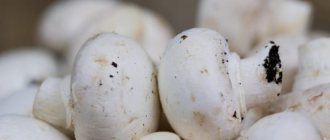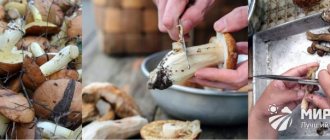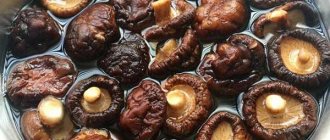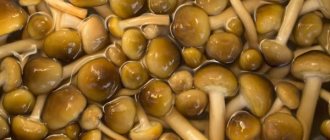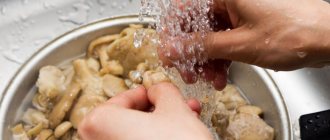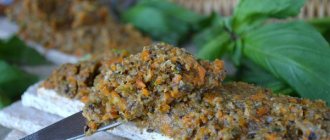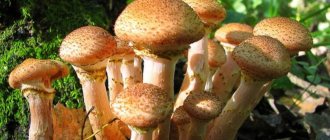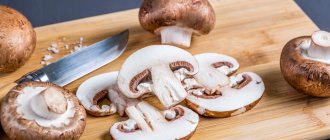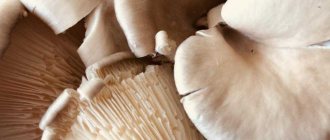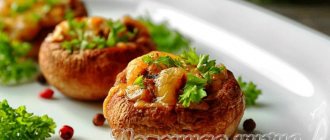If you neglect the rules discussed in this article, you may end up with food poisoning. Of course, it can go away in a mild degree. But where are the guarantees that you will not get serious food poisoning, which will require you to spend more than one day in the hospital? However, if you follow the tips, recommendations and rules from this article, you can avoid the consequences and enjoy delicious mushrooms. So let's find out how to clean champignon mushrooms before cooking them at home.
Basic requirements for processing champignons
If you are collecting forest champignons, then at the collection stage you need to check the mushrooms for worms. And if you are not sure that this is really a champignon (and not a false mushroom, for example), then it is better to ask an experienced mushroom picker for advice (you should always take him into the forest with you) or not to collect this mushroom at all. If you buy champignons in a store, then it is not advisable to do this at the market. Since in such places it is difficult to track the quality and make sure that the mushrooms are really good and edible. In this case, it is better to purchase store branded champignons, since in this case the seller is responsible, and therefore is interested in the high quality of the product.
But how can you determine that champignons are fresh and of high quality, and can be cleaned and then cooked? Good quality champignon has a white or cream color; there should be no strong darkening on the skin (abundant dark spots indicate long-term storage of the mushroom). In this case, the smell should be mushroom (it is very similar to the smell of anise), without notes of dampness or mold. The cut of the champignon leg has a light shade, and the structure of the mushroom itself is dense. These are the signs you can use to determine the freshness and quality of champignons, for which you should check even your own mushrooms. Then the taste and aroma of the cooked champignons will be at a high level, and the risk of poisoning is zero.
Description, taxonomy and characteristics of edible mushroom
The field, common or sidewalk champignon has the Latin name Agaricus arvensis and belongs to the genus of champignons of the champignon family.
There are a number of synonyms in Latin: Psalliota arvensis, Pratella arvensis, Fungus arvensis, Psalliota campestris. In England it is often called horse mushroom due to the fact that this species prefers to grow on horse farms near manure heaps. The cap is thick, fleshy, rounded, somewhat reminiscent of a bell shape, the edges are turned inward, there is a thick veil that covers the lower part. As the cap grows, it opens up and takes on a prostrate shape; a small tubercle remains in the center; remnants of the cover may hang down at the edges.
It reaches 20 cm in diameter, the color is white, less often cream; in older specimens an ocher tint appears. Touching causes the surface to yellow, but this process occurs quite slowly. The cap is covered with fibers or scales; they are often yellowish and can crack during drought.
The hymenophore is the name given to the lower part of the mushroom cap; in the champignon it has the form of plates that are located frequently, slightly swollen, wider towards the edges and loose towards the center. Width - up to 12 mm, white, darken with age and gradually acquire grayish, then brown and finally almost black shades. The spores are dark brown.
The pulp of the champignon is dense, in old fruits it becomes soft and tastes sweet. A subtle yellow tint appears on the cut. There is an aroma of anise or almond, it is most pronounced in young fruits.
The leg reaches a height of 10 cm, and a diameter of up to 1.5 cm, the shape is cylindrical, the surface is smooth, and may expand slightly towards the base. The ring on the stem is wide, white, two-layered, located in the upper part. There is also a lower ring, shorter and yellowish, jagged.
The pulp of the leg is fibrous, in old fruits it acquires a small cavity and is easily separated from the cap. There is a coating in the form of flakes at the base. Repeats the color of the cap, also turns yellow when pressed, but the shade does not change in the lower part.
A little history
The German mycologist Jacob Christian Gottlieb Schaeffer first wrote about the field champignon in 1774. New research was carried out in 1999, which identified two morphotypes of this fungus, possibly representing different species. They differ in the shape and shade of the cap, especially in adulthood.
Video
Cleaning forest mushrooms
After you have sorted through the collected mushrooms and checked their quality and freshness, you can proceed to the next stage. Here we will look at whether it is necessary to clean and how to properly clean wild mushrooms before cooking. First of all, you need to soak the mushrooms in cold water for 10-15 minutes. It is not worth carrying out this procedure longer, since the champignons begin to actively absorb moisture and, as a result, slightly lose their taste and aroma. After soaking, dirt, dust and soil will easily come off the champignons.
The next step is to carefully examine the surface of the mushroom. If there are any minor dark spots, they should be cut off with a knife. And if almost the entire cap or leg is darkened, then it is better to get rid of such a champignon. Next, you must remove the skin from the mushroom cap. Fortunately, this is easy to do: use a knife to hook the skin on the edge of the cap and pull - it will easily come off.
In this case, it is necessary to cut off the lower edge of the mushroom stem by a few millimeters. All that remains is to rinse the champignons under running water and place them on a towel or paper napkins so that the fabric absorbs excess moisture. It is important to note that champignons (even freshly picked ones) should not be stored for more than a day, as they begin to deteriorate and darken. Therefore, we cleaned them before frying and immediately need to heat them.
Advice from experienced mushroom pickers
This section is devoted exclusively to forest mushrooms, which have thicker skins and can also absorb many harmful substances from the atmosphere. Many people know how to clean champignons, but not everyone knows what to do to ensure that this procedure is not only quick, but also protects you from possible poisoning. Let's consider the recommendations of experienced mushroom pickers.
- Soak the mushrooms for 1 hour, drain the water 2 times . Everyone knows that mushrooms are a sponge that absorbs everything from the atmosphere. If you collect them near the highway, factories and other objects, you need to soak them in water. It flushes out 90% of all toxins, and the other 10% will disappear during heat treatment.
- Add a little vinegar or 100 g of lemon juice per 10 liters of water to wash the mushrooms and leave them in this suspension for at least 20 minutes. They absorb lemon juice, which kills all infections and removes toxins.
- Pour boiling water over it. The skin of the mushroom “bounces” much better; you can even remove it with your hands.
We have provided several recommendations on whether it is necessary to clean champignons and what is the best way to do this. But it’s up to you to choose the most convenient one!
Champignons from the store
People often ask: are store-bought champignons washed? Typically, such mushrooms are grown on special plantations where environmental damage is minimal. However, it is imperative to wash and peel the champignons, even if you bought royal champignons. As in the case of wild mushrooms, store-bought ones must be cleaned of dirt and dust. But in this case there is no need to soak them, just gently brush them with a toothbrush or wipe them with wet wipes (the material must be without any additives).
If you bought mushrooms that have not had the skin removed from their caps, then you need to do it yourself. Fortunately, this is easy to do: use a knife to hook the skin on the edge of the cap and pull - it will easily come off. It is also necessary to cut off dark areas if they are minor. If there are a lot of dark spots, then the question should immediately arise about the quality of the purchased products and whether they should be further cleaned or simply thrown away.
The last step is to wash the champignons under running water and dry them with a towel or thick paper napkin. If you do not plan to cook mushrooms in the near future, then you should not peel the champignons in advance. Since they can spoil, and if this does not happen, they will definitely lose their taste. Now you know how to clean champignons, but the processing of mushrooms before cooking does not end there.
Features of preparing champignons
Since this product is rich in proteins, minerals, and vitamins, it is important to follow the requirements of the recipe to preserve them when preparing dishes. Let us consider, as an example, the technology for producing fried champignons, which are often used as an independent dish or a semi-finished product for minced meat.
After processing the raw materials and cutting into slices, the mushrooms are laid out in a thin layer on a preheated frying pan (with a small amount of oil). For preparation, a specially designated and marked board is used. Since different categories have their own surface, for convenient storage of equipment it is advisable to purchase a special wall shelf for boards.
Recipe step by step
Using the same fried champignons as an example, let us consider the generally accepted technological requirements for the consumption of products for high-quality cooking.
Preparing for frying
Royal champignon is often used for frying and further consumption. It must be prepared before frying in the same way as other mushrooms. It is important to note that champignons are rarely used as a main dish; mushrooms are usually served with rice, potatoes or pasta. This means that in order for the dish to turn out most delicious, it is necessary to properly clean and process the champignons. The first rule: the less moisture is used, the crispier the mushrooms will be. Therefore, you should not keep the champignons in water, but you should rinse them under running water as quickly but effectively as possible.
The detailed preparation of champignons before frying is described in detail above. After the last stage - washing and drying the mushrooms - the champignons must be cut into portions. It is not recommended to fry whole legs and caps, as this will take longer. This means that if exposed to high temperatures for too long, the mushrooms will lose their taste. It is equally important to note that you should not peel the mushrooms in advance. Because if they sit, they will lose their taste, and they may also darken. Therefore, champignons should be cleaned immediately before frying. By the way, you can find recipes for fried mushrooms in the article “Fried champignons for the winter.”
How long can you store fresh champignons in the refrigerator and how?
Champignons are one of the safest mushrooms. However, they lose their nutritional and taste qualities when stored in the refrigerator for a long time, and can accumulate harmful substances.
- If you bought open champignons, you can store them in the refrigerator only for 3 days.
- Film-covered champignons can be stored in the refrigerator for about 6 days. After this period, the mushrooms may darken and may also accumulate substances hazardous to the body.
- Increases the shelf life of frozen champignons. It is better to defrost mushrooms in parts and use the entire portion at once. It is not recommended to refreeze mushrooms.
The shelf life of fried mushrooms can be 6 months. However, for this you need to fry mushrooms according to a special recipe:
- champignons are washed before frying
- fry in a deep frying pan with added oil until excess moisture evaporates
- mushrooms prepared in this way are placed in closed containers and stored in the refrigerator
- frozen mushrooms are stored in portioned, tied bags for 6 months
Champignons can be stored in the bottom section of the refrigerator for up to a week.
Right choice
It is extremely important to choose the right champignons, especially when it comes to store-bought ones. Good quality champignon has a white or cream color; there should be no strong darkening on the skin (abundant dark spots indicate long-term storage of the mushroom). In this case, the smell should be mushroom (it is very similar to the smell of anise), without notes of dampness or mold. The cut of the champignon leg has a light shade, and the structure of the mushroom itself is dense. These are the signs you can use to determine the freshness and quality of champignons, for which you should check even your own mushrooms. Then the taste and aroma of the cooked champignons will be at a high level, and the risk of poisoning is zero.
Photo gallery: external differences between different types of champignons
Regular champignons are large, with large caps, matte white or pinkish in color.
Garden mushrooms are usually slightly smaller in size than other mushrooms
This variety stands out for its pink cap and long stem.
Double-ringed champignons have dense, elastic and large caps
Nodule champignons can be distinguished by their beige skin tone
Why peel and wash champignons?
It would seem, why clean the champignons before cooking if you still have to boil or fry them afterwards. More experienced mushroom pickers know that mushrooms from the forest are always dirty: they are covered in dust, soil or some other contaminant. In addition, insects or pathogenic microflora can settle inside the cap or stem. By the way, it is not at all recommended to pick mushrooms near the road, as they accumulate car exhaust gases, which can lead to poisoning of the body. And if we are talking about store-bought champignons, then you shouldn’t leave everything to chance. Since on plantations where mushrooms are grown, sanitation rules are not always followed. This means that mushrooms may contain dust and pathogenic microflora, which can lead to poisoning. Therefore, it is extremely important to soak the mushrooms and then clean them according to all the rules described in this article. This means that processing of champignons before cooking is mandatory.
What else you need to know: how to clean champignons quickly and tastefully
Like preparing any dish, the question of how to clean champignons and preserve the taste of a culinary masterpiece worries every housewife. It is worth noting several subtleties when working with these mushrooms:
1. It is necessary to clean the champignons just before cooking. Peeled and chopped mushrooms lose their beneficial and taste properties in a matter of hours.
2. You can often observe so-called “skirts” in champignons. They do not pose any danger and can be cut solely for aesthetic purposes.
3. Excess water takes away the taste and aroma of the champignons. For this reason, the mushrooms are quickly washed under running water and dried with a paper towel.
4. Mushrooms are cut not only to make eating the finished dish more convenient. In this way it is possible to achieve full development of taste. Therefore, when marinating, small mushrooms are also chosen so that they are quickly saturated with spices and filling.
Do I need to soak champignons?
You need to soak mushrooms if they are wild mushrooms, that is, you picked them with your own hands. This will allow you to clean them faster and remove most of the dirt. But at the same time, high humidity negatively affects the taste of mushrooms, as they quickly absorb water. This means that store-bought mushrooms need to be cleaned, but not soaked. Firstly, this is not necessary, and secondly, refusing these actions will allow you to completely preserve the taste. Therefore, it is enough to rinse store-bought champignons under running water and quickly dry them with thick napkins or a paper towel. The stage of cleaning champignons was discussed in more detail in the article above.
The benefits and harms of champignons
If the fruits grew in good conditions and did not have time to absorb environmental toxins, then they can be consumed even by pregnant and nursing mothers.
Important!
Forest harvests can only be harmful to people with serious gastrointestinal problems and allergies, but the benefits of eating mushroom dishes are simply enormous.
The mushroom contains a lot of useful substances for humans:
- Minerals: manganese, magnesium, calcium, zinc, sodium, iron.
- Vitamins of group B, E, C, PP, D.
- They contain protein that is easily digestible. Minerals together with protein speed up metabolism, so this product is often included in various dietary dishes.
In addition, the product is also consumed raw - in snacks and salads. When cooked, some of the beneficial substances disappear, but excellent taste is revealed.
How to properly wash mushrooms
The cleaned champignon must be rinsed again under running water to get rid of any remaining debris and small particles of dirt. But it needs to be done correctly. Anyone who has encountered mushrooms knows that champignons are fragile and break easily. Therefore, you should wash them as carefully as possible so as not to break or damage them. Many people who are inexperienced in this matter begin to wash them under the tap, which is definitely not worth doing. It is necessary to fill a basin or bowl with warm or slightly cool water and quickly wash the champignons in it. After this, the peeled mushrooms must be placed on a napkin or towel so that the material absorbs excess moisture. Some people boil the mushrooms in salt water for 5 minutes after washing them. If you are sure that the forest where the champignons were collected has a clean environment and no pollution, then it is not at all necessary to boil in water.
Secrets of processing mushrooms
Peeled champignons cannot be stored for a long time, so they need to be processed specifically before cooking. If this happens, then the mushrooms need to be boiled or fried, then they can be stored for a week.
The freezer can help extend the life of fresh peeled mushrooms. You can freeze washed and dried mushrooms, cut into slices or whole. The main condition for freezing is the dryness of the prepared champignons and the tightness of the packaging.
REFERENCE! Mushrooms can be stored frozen for a year at a temperature of -18 0C.
In addition, you can buy already chopped and frozen mushrooms in the store, which will not be much more expensive than fresh mushrooms.
Preparing champignons before harvesting
Depending on further harvesting and heat treatment, the preparation of champignons may vary. Typically, these mushrooms are fried, boiled, baked, frozen or dried. This means that each type of preparation requires its own processing of champignons. But they have one general rule: you need to peel mushrooms immediately before cooking, but not in advance. This point has already been mentioned in the article above, and the point is that peeled champignons quickly deteriorate in the fresh air. Therefore, in order to maintain all the taste at a high level, it is necessary to clean, process and cook as quickly as possible.
Frying
Champignons are often fried in a slow cooker or in a frying pan. You can find recipes for fried mushrooms in the article “Fried champignons for the winter.” It is important to note that champignons are rarely used as a main dish; mushrooms are usually served with rice, potatoes or pasta. This means that in order for the dish to turn out most delicious, it is necessary to properly clean and process the champignons. The first rule: the less moisture is used, the crispier the mushrooms will be. Therefore, you should not keep the champignons in water, but you should rinse them under running water as quickly but effectively as possible.
The detailed preparation of champignons before frying is described in detail above. After the last stage - washing and drying the mushrooms - the champignons must be cut into portions. It is not recommended to fry whole legs and caps, as this will take longer. This means that if exposed to high temperatures for too long, the mushrooms will lose their taste. It is equally important to note that you should not peel the mushrooms in advance. Because if they sit, they will lose their taste, and they may also darken. Therefore, champignons should be cleaned immediately before frying.
Cooking
Before cooking, it is extremely important to rinse the champignons thoroughly (this must be done even more thoroughly than before frying or other methods of preparation). At the same time, it is important to trim the leg, although many housewives forget to do this. But removing small dark spots (provided they are small) is not necessary. Since during cooking all harmful substances will come out anyway, moreover, darkening after such heat treatment will not be visible. By the way, if you have a bad environment in your area, then after cleaning the champignons you must boil them in salt water for 5 minutes. This will reduce the risk of poisoning or infection to 0.
Baking
When baking, in most cases, large champignon caps are used, from which all the plates are removed. To do this as simply as possible, you need to soak the mushrooms in warm or slightly cool water for 5-10 minutes. In this case, you need to dilute 1-2 tablespoons of wheat flour in the liquid. This substance will act as an abrasive substance, which will not only make it easy to remove the plates, but also clean the caps from the skin. After this processing and cleaning, the champignons can be baked according to the chosen recipe.
Freezing
Before freezing, be sure to cut off all darkened spots. Since while in a refrigerated state, the mushrooms begin to darken. And if there are dark spots on the surface in advance, then this process will go much faster. It is worth noting that many recipes do not write, but it is advisable to cut the mushrooms into slices and sprinkle with lemon juice, then wrap in cling film. By the way, if you plan to cook or stew frozen champignons, you do not need to defrost the mushrooms first. You can save time and send them frozen to a saucepan or slow cooker.
Drying
There is no need to wash champignons before drying. Since wet mushrooms, according to the laws of physics, will dry many times longer. Because of this, the taste may suffer, and the pulp will not be as aromatic. 2-3 hours before drying, the mushrooms can be quickly rinsed in water to remove dirt and dust (you can even soak them for 5 minutes), and then be sure to place them on a towel so that the fabric absorbs all the moisture. By the way, damaged and broken champignons are not suitable for drying. Therefore, during processing, when you peel mushrooms, you need to take careful steps so as not to accidentally break the stem or cap.
Fresh mushrooms
Some mushroom gourmets prefer to eat fresh champignons. But in this case, the mushrooms require special treatment to destroy all pathogenic microflora. You need to clean the champignons thoroughly, removing all darkened areas, and do not forget to rinse them in a bowl of water. But even with the most careful processing, there remains a risk of poisoning from fresh mushrooms. To reduce it to zero, you need to place fresh champignons in the oven or a conventional oven for 30-60 seconds. You can also boil the mushrooms in salt water for 5 minutes, which will also destroy all pathogenic microflora and harmful substances.
Methods for cleaning champignons
The process of cleaning champignons depends on the age of the mushroom and where it grows.
Button
The cap of such mushrooms does not exceed 2 cm in diameter. It is covered with a very thin skin and does not need to be peeled. Preparing young mushrooms will not take much time. It is enough to brush off any remaining soil or substrate and rinse well in running water. Their legs are so small that they are barely visible from under the cap; they are trimmed.
Old or large champignon
These champignons differ from their young counterparts in the size of the cap; it usually exceeds 5 cm in diameter and is covered with dense skin. During heat treatment, it does not soften, so so that it is not felt in the dish, it is first removed. They do this as follows:
- First, brush off any adhered dirt.
- Then use a sharp knife to remove the “skin”, carefully picking up the edge of the cap and pulling it towards its middle.
- Refresh the cut of the leg. If the mushroom has been in the refrigerator for several days, then cut off the entire dried part, since it will be felt in the dish. The cook legs with the roughened “skin” are completely removed.
- Mature mushrooms open up and “skirts” form on their stems. They don't affect the taste in any way, but some people think they look unsightly and remove them.
- The plates under the cap - and the older the mushroom, the more saturated brown they become - can also be cleaned. But remember that they are the ones who give the dish its mushroom aroma and taste.
Cleaning champignons in the forest
Fans of “silent hunting” clean mushrooms right in the forest. The picked mushroom is cleaned of natural debris and soil using a soft food brush. Contaminants are removed from them carefully, using scrubbing movements without pressure, and sorted. Wild mushrooms can be stored in the refrigerator for no more than 5 days.
Store mushroom
There are usually no problems with these mushrooms. They have already undergone initial cleaning and sorting. They are washed, the legs are trimmed again, and damaged areas are cut off. Depending on the age, the skins are removed from the caps and legs. Purchased mushrooms are not stored, but are immediately put into use on the first day after purchase.
A quick cleaning method from the experts
Professional chefs have secrets that allow you to quickly clean champignons:
- To ensure that all the dirt comes off the mushroom instantly, experts recommend soaking them for 20 minutes in hot water;
- large caps can be easily removed from the “skin” using coarse-grained sandpaper, but it will have to be washed frequently in water, as it quickly becomes “clogged”;
- If you scald a mushroom with boiling water, the skin can be easily removed by hand.
How to properly clean champignons
There are several more rules for processing champignons before cooking, which are recommended for every mushroom lover to follow. Of course, at some points they will overlap with those that have already been written in the article above. By the way, if you still have questions on the topic of how to clean champignons with your own hands, you can ask them in the comments under the article. Well, most of your questions can be answered in the article below.
What you need to clean mushrooms
To clean mushrooms you need several liters of water, thick napkins or paper towels, a basin, a container for champignons, the champignons themselves, a knife and, of course, free time. By the way, for easier peeling of the mushroom cap, you can add 1-2 tablespoons of flour to the water in which you will soak the mushrooms. In this case, the skin will easily come away from the cap; you only need to pick it up. The process of how to clean champignons with your own hands will be discussed in the article below.
How to properly clean champignons
Proper cleaning of champignons will provide a tasty, healthy, and most importantly, safe mushroom dish. First of all, you need to soak the mushrooms in cold water for 10-15 minutes. It is not worth carrying out this procedure longer, since the champignons begin to actively absorb moisture and, as a result, slightly lose their taste and aroma. After soaking, dirt, dust and soil will easily come off the champignons.
The next step is to carefully examine the surface of the mushroom. If there are any minor dark spots, they should be cut off with a knife. And if almost the entire cap or leg is darkened, then it is better to get rid of such a champignon. Next, you must remove the skin from the mushroom cap. Fortunately, this is easy to do: use a knife to hook the skin on the edge of the cap and pull - it will easily come off.
In this case, it is necessary to cut off the lower edge of the mushroom stem by a few millimeters. All that remains is to rinse the champignons under running water and place them on a towel or paper napkins so that the fabric absorbs excess moisture. It is important to note that champignons (even freshly picked ones) should not be stored for more than a day, as they begin to deteriorate and darken. Therefore, we cleaned them before frying and immediately need to heat them.
Video: how to clean mushrooms
Of course, it may be difficult to understand from the text how to clean champignons before cooking. Therefore, I strongly recommend watching a video in which the author explains in detail the process of processing mushrooms before further thermal cooking. Be sure to turn on the sound, as the video not only shows, but also tells you some useful tips and life hacks for processing champignons before cooking. Enjoy watching!
Video: dry processing method
In the article above it was noted more than once that the drier the champignons are, the tastier they will be in further preparation. Therefore, I recommend looking at another way to process mushrooms at home. In this case, the author practically does not use water, but cleans the champignons with flour. Of course, this process is somewhat more expensive (after all, flour is more expensive than water), but the mushrooms then turn out to be much tastier, more appetizing and brighter. If we talk about the complexity of processing, then both the dry and wet methods are equal in this indicator. After watching a video with instructions on how to clean champignons, you can choose the option that suits you.
How to prepare mushrooms for further cooking: frying, boiling, drying, freezing
Champignons are often fried in a slow cooker or in a frying pan. You can find recipes for fried mushrooms in the article “Fried champignons for the winter.” It is important to note that champignons are rarely used as a main dish; mushrooms are usually served with rice, potatoes or pasta. This means that in order for the dish to turn out most delicious, it is necessary to properly clean and process the champignons. The first rule: the less moisture is used, the crispier the mushrooms will be. Therefore, you should not keep the champignons in water, but you should rinse them under running water as quickly but effectively as possible.
The detailed preparation of champignons before frying is described in detail above. After the last stage - washing and drying the mushrooms - the champignons must be cut into portions. It is not recommended to fry whole legs and caps, as this will take longer. This means that if exposed to high temperatures for too long, the mushrooms will lose their taste. It is equally important to note that you should not peel the mushrooms in advance. Because if they sit, they will lose their taste, and they may also darken. Therefore, champignons should be cleaned immediately before frying.
Before cooking, it is extremely important to rinse the champignons thoroughly (this must be done even more thoroughly than before frying or other methods of preparation). At the same time, it is important to trim the leg, although many housewives forget to do this. But removing small dark spots (provided they are small) is not necessary. Since during cooking all harmful substances will come out anyway, moreover, darkening after such heat treatment will not be visible. By the way, if you have a bad environment in your area, then after cleaning the champignons you must boil them in salt water for 5 minutes. This will reduce the risk of poisoning or infection to 0.
Before freezing, be sure to cut off all darkened spots. Since while in a refrigerated state, the mushrooms begin to darken. And if there are dark spots on the surface in advance, then this process will go much faster. It is worth noting that many recipes do not write, but it is advisable to cut the mushrooms into slices and sprinkle with lemon juice, then wrap in cling film. By the way, if you plan to cook or stew frozen champignons, you do not need to defrost the mushrooms first. You can save time and send them frozen to a saucepan or slow cooker.
There is no need to wash champignons before drying. Since wet mushrooms, according to the laws of physics, will dry many times longer. Because of this, the taste may suffer, and the pulp will not be as aromatic. 2-3 hours before drying, the mushrooms can be quickly rinsed in water to remove dirt and dust (you can even soak them for 5 minutes), and then be sure to place them on a towel so that the fabric absorbs all the moisture. By the way, damaged and broken champignons are not suitable for drying. Therefore, during processing, when you peel mushrooms, you need to take careful steps so as not to accidentally break the stem or cap.
To wash or not to wash
Many people are sometimes too lazy to wash champignons, which is why they refuse this procedure. But you need to soak the mushrooms, especially if they are wild mushrooms, that is, you picked them with your own hands. This will allow you to clean them faster and remove most of the dirt. But at the same time, high humidity negatively affects the taste of mushrooms, as they quickly absorb water. This means that store-bought mushrooms need to be cleaned, but not soaked. Firstly, this is not necessary, and secondly, refusing these actions will allow you to completely preserve the taste. Therefore, it is enough to rinse store-bought champignons under running water and quickly dry them with thick napkins or a paper towel. The stage of cleaning champignons was discussed in more detail in the article above.
How to clean champignons
Cleaning champignons with your own hands is not difficult. Detailed instructions have already been discussed in the article above. Here I just wanted to describe in a little more detail the process of peeling the skin from the mushroom cap. It will be much easier to do this if you first soak the mushrooms in water and flour or at least sprinkle them with this dry mixture. Then you need to use a knife to pick up the skin from the edge of the mushroom cap and pull it until it completely comes off the champignon. Usually this does not require much effort, so mushrooms are quick and easy to clean.
Main processing steps
In fact, preparing champignons for further cooking or consumption comes down to several stages: examining and sorting the fruiting bodies, washing and peeling the caps to the skin.
Since each of these stages has its own characteristics, it makes sense to consider each of them in more detail.
Rules for preparing mushrooms
To properly clean champignons, you need to prepare them first. This stage largely depends on how you plan to prepare them in the future (Figure 3).
Let's consider several options:
- Before frying, champignons are only cleaned, but not washed, as this will cause them to absorb excess moisture. Simply remove the skin from the cap, cut out the damaged areas and wipe the fruiting bodies with a damp cloth. Then, during the heat treatment, they will acquire a pleasant golden crust.
- To cook, you need to refresh the cut on the stem and thoroughly wash the fruiting bodies under running water. Darkened areas do not need to be cut out, since they do not affect the taste, and after cooking, such defects will not be noticeable.
- Baking champignons also requires some preparation of the mushrooms. As a rule, large caps, cleared of plates, are used for this purpose.
Figure 3. Preparation of champignons depends on their further processing.
If you plan to freeze regular or brown champignons, they need to not only be cleaned and washed, but also dried. In addition, it is advisable to immediately cut them into portions, and then lightly sprinkle them with lemon juice, wrap them in cling film and put them in the freezer. Before drying, small and large champignons are only cleaned of dust and debris, but under no circumstances are they washed. This will make the drying process longer and mold may appear on the surface of the fruiting bodies.
Washing champignons
Before any preparation of mushrooms other than drying, the fruiting bodies must be washed. This will help remove small particles of debris.
Note: In addition to washing the caps and stems under running water, it is also advisable to soak the champignons. Mushrooms collected from the forest are soaked in lightly salted water. A product purchased from a supermarket can be soaked in warm water for 15 minutes and then placed in a colander to drain excess liquid.
After this, the cut on the stalk is renewed, the film is removed from large specimens and the fruiting bodies are washed again under running water. After this, you can begin heat treatment (Figure 4).
Figure 4. Peeled mushrooms must be washed under running water
Some gourmets prefer to eat champignons raw. But remember that such a dish can only be prepared from store-bought mushrooms. Specimens collected from the forest must be subjected to heat treatment.
Cleaning the caps
It is not necessary to clean the caps of store-bought champignons, especially if they are small. But certain nuances still exist.
Figure 5. Large caps need to be peeled
For example, if there is still a need to clean small purchased champignons, you don’t have to peel them, but simply rub them apart. This will help remove even small particles of debris without dealing with each mushroom separately.
If the diameter of the cap is 3 cm or more, it will have to be cleaned with a sharp knife. First you need to remove the film from the outside, then cut out all the darkened areas, and then update the cut on the leg. Immediately after cleaning, the fruiting bodies are washed under running water to remove any debris and skin that may have remained on the surface (Figure 5).
To prevent the champignons from absorbing excess moisture, after washing they are laid out on a paper towel and blotted.
How to quickly peel mushrooms - video
I think many will remember how in childhood, after picking mushrooms, we had to sit and clean them until the evening with the whole family. Of course, this has its joyful moments; it is especially gratifying that the family is united by a common cause. But you still want to do it quickly in order to have more rest or redo other daily tasks. This can be done using the method described in this video. The author tells in detail how to quickly clean champignons with your own hands. I recommend watching it with sound, as the information is no less useful than what is shown. Enjoy watching!
What about washing or boiling mushrooms?
Do champignons need to be boiled? Most mushrooms cannot be washed and boiled by draining the water several times. But champignons are the opposite. Of course, you can object, because mushrooms are such an unpredictable product, how can you use it if you don’t boil it?
The fact is that champignons absorb water well, and they do it very quickly, which can negatively affect your dish. And from cooking, mushrooms can completely lose their taste, losing their qualities into the mushroom broth.
Of course, it is necessary to wash the champignons, you never know what chemicals may have settled on them, but you should not soak them and boil them.
It’s better to rinse the mushrooms and quickly place them on a dry towel, this way you won’t spoil the taste of the mushrooms and, if possible, remove any contamination.
Little tricks for cooking champignons
The first trick, which has been discussed more than once in this article, is that mushrooms need to be kept in water as little as possible. Since the leg and cap of the champignon quickly absorb moisture, which is why they lose their best taste. Therefore, it is not advisable to soak wild mushrooms for more than 10-15 minutes, and purchased champignons do not need to be soaked at all during processing. The second trick is that it is advisable to fry the mushroom caps and legs in crushed form. Thanks to this, you will save time on heat treatment, and the mushrooms will acquire a more appetizing and delicate taste.
Similar species
Both edible and poisonous species are similar to it.
Among the latter, it is important to learn to distinguish:
- Pale toadstool.
Which has white, pale plates. Another sign is that the leg widens towards the lower edge, and a blanket (volva) is located around it. In addition, toadstool does not smell like almonds or anise.
- Yellow-skinned champignon.
It is smaller in size and mainly grows in acacia bushes. A characteristic feature is the smell of carbolic acid, which can be described as “medical” or “pharmacy.” If you make a cut or break the flesh, it will quickly turn yellow.
1- Pale toadstool. 2- Yellow-skinned champignon.
Field champignon is similar to edible representatives of the same family, but differs from them in its larger fruiting body. For example, it is similar to the crooked mushroom , which is mainly found in coniferous forests, including under spruce trees, rather than in open fields.
How to process for raw consumption
There are people who love to eat raw champignons. But in this case, the mushrooms require special treatment to destroy all pathogenic microflora. You need to clean the champignons thoroughly, removing all darkened areas, and do not forget to rinse them in a bowl of water. But even with the most careful processing, there remains a risk of poisoning from fresh mushrooms. To reduce it to zero, you need to place fresh champignons in the oven or a conventional oven for 30-60 seconds. You can also boil the mushrooms in salt water for 5 minutes, which will also destroy all pathogenic microflora and harmful substances.
Choosing champignons
If mushrooms are collected in the forest, they must be carefully sorted and separated from poisonous ones.
When purchasing in a store, choose only dense mushrooms with a light milky, white or brown cap (depending on the type chosen), intact and with a pleasant aroma. If there is a slippery coating on the surface, this is a sure sign that it is spoiled by bacteria, and the mushroom should not be eaten; no amount of cleaning will help get rid of the toxins that these bacteria produce.
The choice of type and size depends on further use and individual taste preferences. Any type is suitable for frying. Small fruits with brown caps are suitable for salad or pizza. They are fragrant and will look good.
When purchasing in a store, choose only dense mushrooms with a light milky, white or brown cap.
Storage Features
You cannot store peeled champignons for a long time, as they begin to darken and then spoil. In general, it is advisable to clean and prepare freshly picked mushrooms during the same day: boil, fry, freeze, dry, bake, or in some other way. And depending on the heat treatment, further storage will depend. But in most cases we are talking about a regular refrigerator. Once again, it is worth noting that peeled champignons need to be cooked for several hours, and it is not necessary to put them in the refrigerator in the meantime.
What are the similarities and differences between toadstool and champignon?
Champignon is easily confused with toadstool, as they are similar. So, they have approximately the same length of the stem and size of the cap. ... The differences are as follows: the champignon has a much thicker, denser base, while the toadstool has a rather thin trunk. The color under the cap of the champignon is pinkish, while the color of the poisonous toadstool is the same as the cap.
Interesting materials:
Why is Tarragon green? Why is the Juul cartridge leaking from below? Why is the new crankshaft oil seal leaking? Why does the TV say there is no CI CAM module? Why does the TV show a red tint? Why does my Samsung TV turn off on its own? Why does the TV turn on after turning off? Why does the iPhone screen darken on its own? Why do stainless steel cookware turn dark? Why is the temperature 36 and 9?
To summarize
Here is such a simple processing of champignons before cooking, which is absolutely required. If you neglect the rules described above, you can be seriously poisoned by unprocessed mushrooms. By the way, do not forget that it is not recommended to collect mushrooms growing near roads, highways and large cities. The fact is that in these areas there are a lot of emissions from cars and factories, and mushrooms, like sponges, absorb all this. This means that the mushroom pulp becomes poisonous and dangerous to human life. Therefore, I strongly recommend going to pick mushrooms as far as possible from cities and highways into the forest, the main thing is not to get lost. If you still have any questions, ask them in the comments below the article. We answer them promptly and in as much detail as possible. Bon appetit, see you soon!
Delicious dishes with champignons
Julienne with champignons and chicken
Julienne is a fairly simple dish, but at the same time very tasty and sophisticated. This dish can be prepared in portions, in a special bowl or in a frying pan or baking dish.
Ingredients:
- chicken breast fillet – 400 g;
- champignons – 400 g;
- onion – 1 piece;
- cream – 200 ml;
- flour – 1 tbsp. l;
- hard cheese – 400 g;
- vegetable oil;
- black pepper;
- salt.
Step-by-step cooking algorithm:
- Wash the chicken breast fillet under running water, place in a saucepan, add water, and cook. After boiling, be sure to add salt. Cook the breast for about 20-30 minutes over medium heat.
- After cooking, the meat is allowed to cool and then cut into small cubes.
- Peel the onion and finely chop.
- Wash the mushrooms under running water and place on napkins to drain. You can cut the mushrooms in any convenient way.
- Place the frying pan on the fire, pour oil, fry the onion.
- Add chopped mushrooms to the fried onions. Fry for 5-10 minutes.
- In a dry frying pan, fry the flour for a few minutes, add cream, salt and pepper to taste. Stirring constantly, bring to a boil.
- Add finely chopped chicken fillet to the pan with mushrooms and onions. Place everything in a baking dish or serving bowl. Pour the prepared sauce over everything. Simmer over low heat for another 10 minutes.
- After this, remove the container from the heat, grate the cheese coarsely on top and place in an oven preheated to +180 degrees for 20 minutes.
Julien is ready. Bon appetit.
Rules for storing mushrooms
If you plan to cook the purchased mushrooms a little later, it is recommended to place the products in the freezer.
There is no need to peel the peel. This procedure is carried out before cooking. You just need to remove large contaminants from the surface of the mushrooms. Frozen champignons can be stored for about 1 year. To extend the storage time of store-bought mushrooms in the refrigerator, you can use lemon juice. Squeeze the citrus and sprinkle the juice over the food. If the champignons have been stored for too long, cut off the stem completely. To save time on cleaning, buy quality mushrooms based on color, texture and smell. Fresh food smells fresh. An additional confirmation of quality is the elastic cap and the absence of signs of rotting. Place purchased products in a container. Then place in the refrigerator or freezer.
The recommendations listed are written for informational purposes only. Even a broken sequence of cleaning mushrooms cannot significantly spoil the taste of the finished dish.
Where to collect champignons?
We will definitely talk about how to process champignons before cooking, but first of all I would like to remind you about proper harvesting.
Of course, it is much easier to buy champignons in a store or market; they are there all year round and reproduce well outside of the wild, but for lovers of “silent hunting” who feel the excitement of collecting mushrooms, it would be useful to know a little about where and how to collect champignons.
First of all, champignons take root anywhere: in forest lowlands, in the mountains, and in meadows. Most often they grow on manure heaps, landfills, even household ones. They like to breed near human habitations and where livestock graze. It's all about soil well fertilized with manure. But sometimes stubborn champignons grow even from under the asphalt. Marvelous! After all, the mushrooms look so weak.
Champignons are hidden under a layer of loose fertile soil. If you see a cap or a tubercle, take the time to dig up the soil; perhaps there is a whole family of mushrooms there. If so, you should pay attention to all the bumps in this area.
In general, there are three types of champignons, they are divided according to their habitat:
- ordinary;
- meadow;
- forest.
All of them are united by the main feature - a large, thick cap, turning pink from the sun. Old mushrooms usually turn black, acquiring a dark, brown color. But the young ones are distinguished by a dense spherical cap and a pleasant color.
Field champignon: description of appearance and photo
Category: edible.
In 1762, the field champignon (Agaricus arvensis) was identified as a separate group by Jacob Schaeffer, a botanist, ornithologist and entomologist, at the University of Wittenberg and Tübingen.
In appearance, field champignon is slightly different from other species. Cap (diameter 7-22 cm): white, gray, cream or light ocher (in old mushrooms) with remnants of a veil. It has the shape of a small egg or bell, but over time it becomes almost prostrate with a noticeable tubercle in the center. The edges of young mushrooms are rolled inward, later becoming wavy. In dry weather they can crack severely, causing them to become uneven and torn. Smooth to the touch, in rare cases it may have small scales. Stipe (height 5-12 cm): usually the same color as the cap, turns yellow when pressed, fibrous, cylindrical in shape and has a large two-layer ring. Often narrows from bottom to top. In young mushrooms it is solid, but over time it becomes hollow. Easily separates from the cap.
Plates: can be white-gray, brownish, with a mustard or purple tint; in old mushrooms they are dark brown or black.
Pulp: white or light yellow, very dense, turns yellow when cut and when exposed to air. Sweet to the taste.
The description and photo of the field champignon are similar to the description and photo of the pale toadstool (Amanita phalloides) and the yellow-skinned champignon (Agaricus xanthodermus).
However, the toadstool does not have an anise-like odor and has a single-layered ring on the stem. And the yellow-skinned champignon has a strong medicinal smell of carbolic acid.
Field champignons grow from late May to early November in the northern regions of Russia.
Where to find: in open spaces of forests, fields and pastures, can be found in mountainous areas, nettle thickets or near spruce trees. Large groups of field mushrooms sometimes form “witch rings.”
Eating: both fresh and after any type of processing. A very tasty mushroom, considered a delicacy in many countries.
Use in folk medicine (the data has not been confirmed and has not undergone clinical studies!): in the form of an extract as an effective remedy in the treatment of diabetes. Decoctions have been used since ancient times in the outback as an antidote for snake bites.
Important! Field champignons often accumulate heavy metals. Cadmium, copper and other elements in large doses can be hazardous to health
Try to collect mushrooms in environmentally friendly areas.
The British call the field champignon horse mushroom - “horse mushroom” because it often grows on horse manure.
